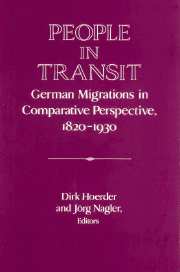Book contents
- Frontmatter
- Introduction
- PART I CONTINUITY AND COMPLEXITY: MIGRATIONS FROM EAST ELBIAN GERMANY AND GALICIAN POLAND
- Part II Internal German Migrations and In-Migrations
- PART III WOMEN'S MIGRATION: LABOR AND MARRIAGE MARKETS
- PART IV ACCULTURATION IN AND RETURN FROM THE UNITED STATES
- 14 Communicating the Old and the New: German Immigrant Women and Their Press in Comparative Perspective around 1900
- 15 Return Migration to an Urban Center: The Example of Bremen, 1850-1914
- 16 Migration, Ethnicity, and Working-Class Formation: Passaic, New Jersey, 1889-1926
- 17 Changing Gender Roles and Emigration: The Example of German Jewish Women and Their Emigration to the United States, 1933-1945
- 18 Migration Past and Present - The German Experience
- 19 Research on the German Migrations, 1820s to 1930s: A Report on the State of German Scholarship
- Index
17 - Changing Gender Roles and Emigration: The Example of German Jewish Women and Their Emigration to the United States, 1933-1945
Published online by Cambridge University Press: 05 January 2013
- Frontmatter
- Introduction
- PART I CONTINUITY AND COMPLEXITY: MIGRATIONS FROM EAST ELBIAN GERMANY AND GALICIAN POLAND
- Part II Internal German Migrations and In-Migrations
- PART III WOMEN'S MIGRATION: LABOR AND MARRIAGE MARKETS
- PART IV ACCULTURATION IN AND RETURN FROM THE UNITED STATES
- 14 Communicating the Old and the New: German Immigrant Women and Their Press in Comparative Perspective around 1900
- 15 Return Migration to an Urban Center: The Example of Bremen, 1850-1914
- 16 Migration, Ethnicity, and Working-Class Formation: Passaic, New Jersey, 1889-1926
- 17 Changing Gender Roles and Emigration: The Example of German Jewish Women and Their Emigration to the United States, 1933-1945
- 18 Migration Past and Present - The German Experience
- 19 Research on the German Migrations, 1820s to 1930s: A Report on the State of German Scholarship
- Index
Summary
In 1939 an American social worker, who worked with German Jewish refugee boys, expressed her frustration: “The boys looked upon women as housekeepers and could not imagine requesting guidance from a woman.” The refugee boy, her report went on to say, “has contempt for women as anything but the mother and housekeeper.” At about the same time, another social worker described two adult emigrants from Germany standing in the hall of a refugee aid organization and talking: “Go into the last room,” one of them insisted, “there you will find a man.”
Those reports from the late 1930s provide eloquent testimony as to how American professional women viewed the newly arrived refugees from Germany and how they expressed their astonishment, sometimes anger, about certain attitudes that those refugees held. They call out for a focus on the gender relations in German Jewish families in the 1930s. Was it really the old traditional and patriarchal family as one would expect from these statements? How were gender roles defined? Did women take care of their children and households while men worked and made all major decisions?
In this essay, I will show that during the Nazi era, specifically the period from 1933 to 1939, gender roles in the Jewish community and in Jewish families underwent a process of change. I will also argue that these changed gender roles were carried along during their emigration to the United States. In fact, this change played a decisive role in the social history of German Jewish immigrants in the United States and their successful adjustment to this country.
- Type
- Chapter
- Information
- People in TransitGerman Migrations in Comparative Perspective, 1820–1930, pp. 379 - 398Publisher: Cambridge University PressPrint publication year: 1995



